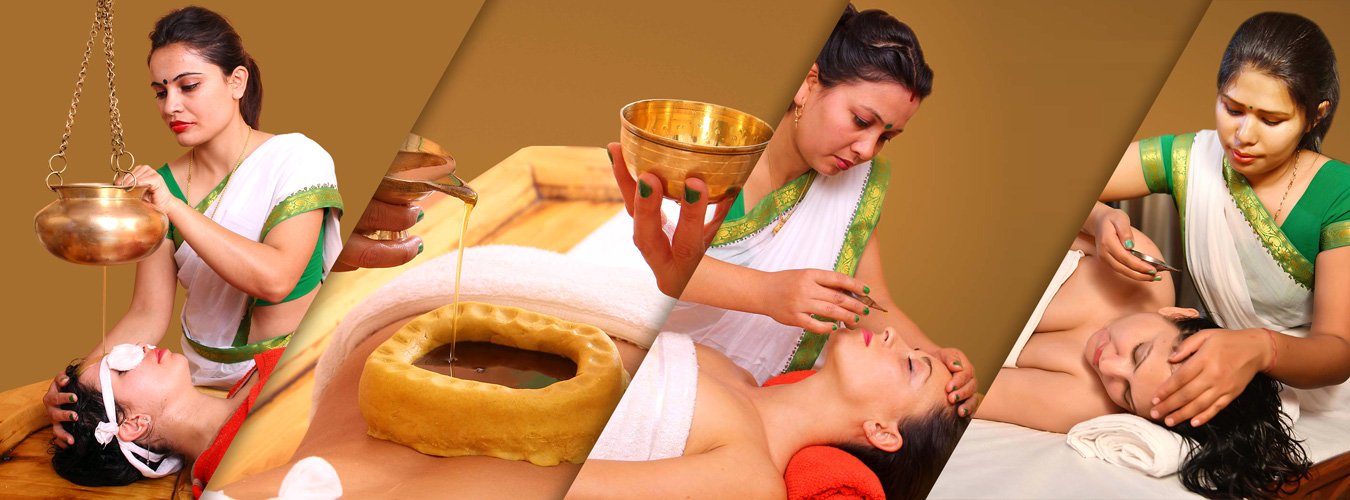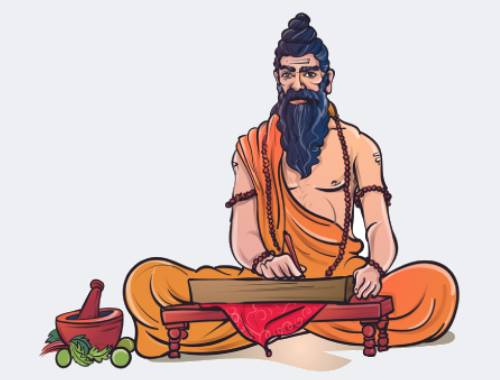

According to the oldest written texts "the Vedas" the principles of Ayurveda were spoken by the "Creator" himself Brahma. It is an ancient science which deals with the flow of energy in the human body. It is known as eternal as no one actually knows when it came and how it came. The Ayurvedic texts are called upavedas and run parallel to the Vedas timeline. Ayurveda literally means "Knowledge of Life" in Sanskrit.
The philosophy of this ancient science views man as a complex system consisting of four vital parts – the body, the soul, the six senses and the mind. Ayurvedic texts have mentioned that a human is entwined indefinitely with the nature and the cosmos. Health is not only related to a state of the body.

The body is exposed to different seasons, magnetic changes due to planetary motions, relationship with humans, animals and plants. Each and every experience affects the human mind and body. Keeping a balance to all these elements is the way one can keep healthy. The whole life journey from birth to death is considered very sacred in Ayurveda.
The Sanskrit verse "Ayurasminvidyate" defines Ayurveda. It means Ayurveda is a science which deals with "Ayur" (life) and how to prolong the life-span. Another verse "Sarir endriya satvat masam yogo dhari jivitam" also tells what Ayurveda deals with. It deals with good, bad, happy and unhappy parts of life, the life span, nature and promotes healthy lifestyle.
There are three things that make life – body, self (spirit) and mind. The living being is called Purusha and the three things are contained in him. Ayurveda simplifies the organization of Human body unlike modern medical science. The body’s layout is considered to consist of three elements viz. Doshas, Dhatus and Mala. Doshas are the body humours, Dhatus are the tissues and Mala are the impurities. While specifying a treatment these three things are considered.
A human being as an individual is composed of spirit which desires to express itself using the mind and the body. The expression is done through sense organs. Body is the carrier of the higher energies sprit and mind and is made of Panch Mahabhutas (Five Greater Elements). These Panch Mahabhutas combine to form the Three Doshas in the human body. The three Doshas are a combination of energy and bio-force that is responsible for our physical health. The three psychic forces of Rajas (activity), Tamas (inertia) and Satvam (Truthfulness) are the elements which determine our mental health. Ayurveda is a system of health care which balances all these elements to achieve optimum health.
Ayurveda is a science which gives knowledge about the causes of disease, the symptoms of disease and the way to remove the causes and symptoms.
Ayurveda is quite distinct from other systems of treatment and medicine. The distinguishing features of this ancient system of medicine are:
There are three fundamental energies which regulates all the natural processes at macro and micro level. This is the same energy system which is responsible for the creation, movement and destruction of the Galaxies and the star systems. So, the human physiology is connected to the Universe according to Ayurvedic science. Tridoshas is the name given to these three universal energies.
Ayurveda believes that there is one super energy source (Paramatma). All the energy, wisdom and intelligence come from this energy source. The energy flow from this ultimate power to the human (Purusha) is directed through the nature (Prakriti). Ayurveda merely assists in this process by keeping a harmonious relation between individuals and nature.
The focus of Ayurveda is to balance the energies responsible for life, and it does not take the course of treating the symptoms. Unlike other medical systems Ayurvedic treatment is focused on removing the cause of disease.
Every individual has a unique body. This is the concept on which Ayurvedic treatments work. So, every individual will have different treatment even if they have the same disease.
Mind and body are both a part of the human being and the overall health is comprised of healthy mind and healthy body.
The Tridoshas can be balanced by therapies and exercises, and the mind can be balanced by practicing meditation, Japa and Pranayama.
The five basic elements that make up the human body are fire (Agni), earth (Prithvi), water (jal), air (Vayu) and space (Akaash). The Tridoshas are made up of these elements and every person is born with a unique combination of the doshas. This unique combination determines the person’s composition (Prakruti). Ayurveda yearns to understand this element and all the treatments are based on the Prakruti. The treatment includes diet, exercises, detoxification, and herbal and chemical medication along with rejuvenation therapy.
Ayurveda is comprised of six basic principles which guide the whole system. They are:
The Three Fundamental Psychic Energies – There are three universal psychic energy systems as per Ayurveda. They are Sattvic (Truthfulness), Rajas (activity of body) and Tamas (Body in motion or inertia). All human beings are a mixture of all three psychic energies, but one of the three is dominant and that determines the type of mental status. The way to keep healthy is to balance the three. Sattvic is truthfulness and is purest of the three psychic forces. It activates the senses for grasping knowledge. Rajas is the most active psychic force. It is guided by motion and stimulation. It is the driving force behind all desires, ambitions and wishes. Imbalance can cause fickle mindedness and lack of the power to make decisions. Tamas the inertia causes resistance to change. Imbalance causes laziness, delusion and ego. Sattvic psychic energy is pure and free of negativity while Rajas and Tamas are with negativity. They can be unbalanced by greed, anxiety, anger, fear and stress. People dominated by Sattvic force are calm and noble, those dominated by Rajas are greedy and lustful and people whom Tamas dominates are lazy and full of ego.
The five Basic elements – These elements are known as Panch Maha Bhutas and comprise of earth (Prithvi), water (Jal), air (Vayu), fire (Agni) and space (Akaash). The basic elements are mixed in infinite ways to produce uniquely different matter. The single celled organism the earth element is predominant. However every living being consists of all five elements. So the cytoplasm in the single celled organism is the water element, the metabolism is the fire element, the gaseous exchange is the air element and the space occupied by the cell is the space element. In multi-cellular beings like us space consists of space in the body like mouth, nasal cavity, stomach etc., Agni consists of the enzyme functioning, Vayu makes the movement of muscular system (Voluntary) and the nervous system (Voluntary and Involuntary), water is the dominating element making up two-third of the body and makes the fluids like plasma, saliva etc., and the earth element which makes the structure of the body in the form of skeletal structure, hair, flesh and skin.
The three body Humours – They are popularly known as Tridoshas and are known as Vata, Pitta and Kapha. They dominate the functioning of the whole body. They are derived from the five basic elements and each Dosha is made up of two basic elements. All the diseases can be explained in terms of the three Doshas. The Vata Dosha is made of the two elements Vayu and Akaash and the body physiology can be explained by this Dosha. It is light, cold and dry in nature. The Pitta Dosha is made of Agni and Jal and all the chemical processes in the body which comprise hormones, enzymes and other juices can be attributed to it. It is light, hot and oily in nature. The Kapha made of Jal and Prithvi elements explains the skeletal and anabolic systems. It is heavy, cold and oily in nature.
The seven body tissues – Described in Ayurvedic texts as “Dhatu” they include seven tissues. The tissues mentioned are fluid tissue (Rasa Dhatu), blood tissue (Rakta Dhatu), Muscle tissue (Mamsa Dhatu), fat tissue (Meda Dhatu), bone tissue (Asthi Dhatu), nervous tissues (Majja Dhatu) and the reproductive tissues (Shukra Dhatu).
The thirteen fires of digestion – They are Digestive fire (arising from the stomach), Seven tissue fires (arising from the seven tissues and are seven in number) and five elemental fire (arising from five elements in the body and are five in number).
The three impurities - The body wastes have been classified into three kinds in Ayurveda viz. Faeces, Urine and Sweat. All the toxins are pushed out by the body in the form of these three impurities. Faeces are the impurities left after the nutrients from solid food are absorbed by the intestines. Urine is formed after the water in the food and the water we drink goes through the purifying organs and the toxins are collected and eliminated through it. It regulates the water in our body. Sweat is formed by burning of fat and is responsible for maintaining the body temperature.
At Haritha Ayurvedic center the basic principles of Ayurveda are followed diligently to give a personalized treatment that purifies the body and mind. We have therapists which includes experienced Ayurvedic Doctors with the knowledge of human systems. They design therapies which will take you health to a different level altogether.
Haritha Ayurveda Academy & Panchakarma center offers many Ayurveda short-term and long-term courses and wellness retreats programes in Rishikesh, India.
Place your enquiry in the contact form below. We will contact you to provide our packages and courses detail on your email.